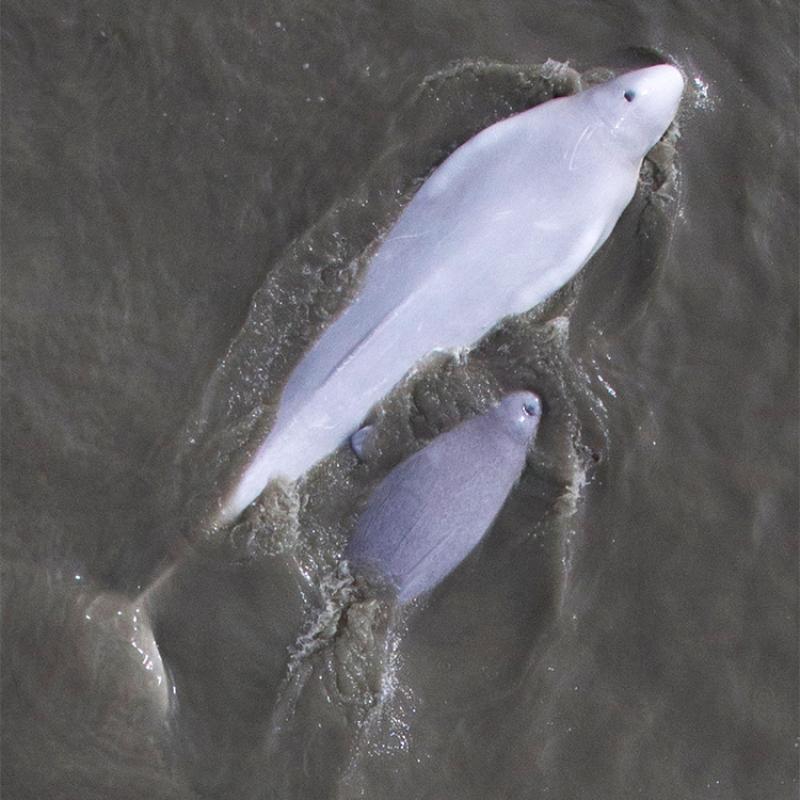A key challenge for recovering endangered Cook Inlet beluga whales is understanding how the interplay between prey availability and human activities affect the health of individual animals and the overall population. Scientists have developed a new model that provides insights on how these two factors may influence pregnant beluga whales' decisions about where and when to forage and, ultimately, their overall health.
“We focused initially on developing a model to study pregnant females because of recent evidence indicating reproductive rates may be depressed in Cook Inlet belugas,” said Elizabeth McHuron, the Cooperative Institute for Climate, Ocean and Ecosystem Studies, University of Washington.
Cook Inlet belugas are estimated to number between 250 and 317 animals. They are particularly vulnerable to changes in prey availability, and noise, pollution and other human disturbances due to:
- Restricted geographic range
- Geographic isolation
- Low population density
- Low productivity
- Extended maternal care
- Large body size
Human influences are of concern given the proximity of belugas to Anchorage, which lies at the northern end of Cook Inlet. It is home to roughly 40 percent of Alaska’s human population.
To learn more about how prey availability and human activities may be affecting belugas, scientists used the model to predict female beluga behavioral decisions and habitat use. They looked at how belugas responded under different environmental and human disturbance scenarios.
Scientists were then able to estimate the resulting impacts on pregnant females’ body condition, growth, survival and reproduction.
What they learned was that female health declined under some conditions but, surprisingly, not in all cases.
Predicting Beluga Whale Feeding Behavior
Using their new model, scientists were able to predict female whales’ behavioral decisions (whether to forage, travel to a new location, or rest) given changes in prey abundance across habitats and seasons.
In all scenarios, feeding activity was highest during summer to capitalize on abundant prey (e.g., salmon eulachon, etc.). This resulted in large increases in blubber reserves that pregnant belugas relied on during October to April when prey was assumed to be less abundant.
Prey availability outside of summer months was still critical, as it either exacerbated or buffered against reductions in prey availability during summer months.
Spatial predictions of habitat use indicated that pregnant belugas should forage in areas used historically that now appear to be abandoned. This suggests that prey availability alone is unlikely to explain the recent range contraction of belugas to upper Cook Inlet.
Interplay Between Prey Availability and Human Activities Has Varying Impact on Female Beluga Health
The model provides insights into conditions under which reductions in female survival and reproductive rates, also called vital rates, and body condition might be expected. Reductions in prey availability from late spring to early fall adversely affected female vital rates. Intermittent disturbances adversely affect survival and reproductive success when they occur in environments with reduced prey availability.
However, intermittent disturbances that resulted in lost foraging opportunities, such as those caused by human activities during the ice-free season, had little impact on female body condition or vital rates if prey were abundant during the summer and early fall and some prey were available during the winter.
“We need to quantify the effects of prey availability and disturbance from human activities on individual health and at the population level, at multiple timescales,” said Kim Goetz, marine mammal biologist, Alaska Fisheries Science Center. “This is critical science needed for effective management and conservation of Cook Inlet beluga whales.”
Future Model Development to Examine Population Impacts
This effort is an initial step to develop a Population Consequences of Disturbance model. This population model can be used to better understand the influence of various factors and how they may be working, in concert, to affect the endangered whale’s recovery.
According to McHuron, results from the model suggest that the effects of disturbance from human activities on belugas are inextricably linked with prey availability.
“As a result, accurately assessing the effects of human disturbance cannot be done in isolation,” she said.
Further work and data are needed to explore the cumulative impacts of multiple stressors on this population. This includes examining year-round availability and spatial distribution of prey and beluga behavioral responses to human activities.
NOAA Fisheries has designated Cook Inlet belugas as one of nine “Species in the Spotlight.” The initiative brings attention to and helps mobilize resources to recover species most highly at risk of extinction. In 2023, NOAA Fisheries celebrates the 50th anniversary of the Endangered Species Act, a major milestone for the conservation of protected species and their habitats.


